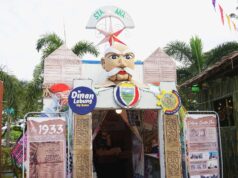(Editor’s note: This story, covered on Dec. 13, 2005, is rewritten in memory of Joey Estriber, environmental activist and radio broadcaster, who was abducted by alleged soldiers on March 3, 2006. Estriber has not been surfaced since then.)
BALER, Aurora – In the new mining frontier that is Aurora, communities fighting off 31 contracts and applications over 277,335 hectares, or roughly 83 percent of the province’s land area, have taken their cause to a new level.
They have established links with communities in Marinduque where the mining industry performed its worst and in Benguet where it is still facing opposition.
Remy Gutierrez of the Multi-Sectoral Action Group (Msag), the event’s organizer, said: “We want to learn from their experiences and get support from them. We can succeed in our campaign against large-scale mining if we link together.”
Bishop Emeritus Julio Xavier Labayen of the Prelature of Infanta, Quezon has rallied the communities to oppose mining and logging.
“The defense of the environment and our right to its resources are in keeping up with the Gospel truth that what God created belongs to us all and not only to a few. We are tasked to put it to good use,” the bishop said in Filipino.
The conference is held as the Arroyo government revitalizes the mining sector by liberalizing its investments climate to be able to boost income from exports and create jobs as well.
This comes without any legal hitch, with the Supreme Court upholding the constitutionality of the Mining Act of 1995 despite provisions that may impact on national patrimony through increased foreign ownership and incentives, according to John Vergara of the Kalikasan People’s Network for the Environment.
The Philippines is naturally attractive to mining prospectors. It ranks third in the world in terms of gold deposits, fourth in copper, fifth in nickel and sixth in chromite as of 2000, according to the Mines and Geosciences Bureau.
The economic potential is huge, with the MGB estimating the total value of mineral resources at between $840 million and $1 trillion. But this, said the MGB, is largely untapped. The mining sector put in a share of only 1.05 percent to the gross national product for 2000.
The conference is also held as mining industry vows to go for responsible and sustainable mining.
Msag, said Gutierrez, meets these with cynicism and prefers to listen to those that hosted mining projects. It did get loads of advice.
WITNESSING
“Resist mining projects even before these are started at the exploration level,” said Edmundo Ola as he shared the lessons of the church-led Marinduque Council for Environmental Concerns in dealing with the disasters wrought by the operations of the Marcopper and Placer Dome and in stopping the plan of the companies to resume operations.
Vividly and aided by enlarged photographs, Ola recounted how the island’s forests, watersheds, rivers, fishing grounds and farms took a “slow but sure form of destruction” as the firms extracted gold, silver and copper starting in the 1930s.
Eventually, he added, the disasters unfolded in serious, irreversible degrees, seeing the province declared under a state of calamity in 1996.
On Dec. 6, 1993, he said the Maguilaguila siltation dam collapsed, flooding his village Mogpog, killing two children and contaminating the rivers and farms there.
But the worst, he added, occurred on March 24, 1996 when three million cubic meters of mine tailings spilled and filled the 27-km stretch of the Boac river, killing this and other resources in the vicinity.
While the information drew enough hostile reactions from the more than 100 local leaders, Ola’s showing of a list of names of almost 50 people who died of ailments linked to mercury and cyanide exposure has triggered angry remarks.
Ola believed hundreds more are sick but remained undocumented and untreated due to lack of funds for health remediation.
“The cleanup which was begun only in 2000 was discontinued. This exposes us to health risks,” he told the audience.
While people’s protests took time to shape into a formidable force as residents held on to jobs, local governments relied on taxes and some politicians supported business, two things good came out, Ola said.
The provincial government declared a 50-year moratorium on mining in the island. Last October in Nevada, it filed a class suit for damages against the companies.
“They dumped their wastes, they dumped their responsibilities,” said Ola, adding: “You can only fight large-scale mining if you unite.”
GO LOCAL
Esther Tecne of the Itogon Inter-Barangay Alliance stressed two points. She told Aurora leaders of the need to start the fight at the village level and to brace for deception. Such happened as indigenous tribes wrestled with the Benguet Corp. since 1903, she said.
In Itogon in 1991 to 1992, she said the residents fought en masse by putting up human barricades. Mass arrests, she recalled, became a problem with the police that eventually had to release the protesters. “They could not feed all of us in prison,” she chuckled.
The company instead shifted site to nearby Ucab for its open pit mining. However, she said, the water shortage there is felt in her village.
And accidents, she noted, were all around them. In Mankayan and Tubu, the dams or tailing ponds of the Itogon-Suyoc Mines, Philex Mining Corp. and Lepanto Consolidated Mining Corp. either collapsed or was overtopped after a typhoon, earthquake or additional loading of silt.
As a result, she said the Abra River had been silted, polluting the irrigation source and fishing grounds of nine towns.
Her cause for worry now concerns the way by which companies are obtaining free and prior consent rights from communities. “The new mining law has shortened the process and assigned that right from local officials or few elders,” she said.
Tecne capped her witnessing by singing the reasons for the defense of local resources: “Remember your children, remember our future, remember Mother Nature.” Written by Cordillera artists, the song is what she sings every night to her grandson Rhojan, 4.
Vergara said 16 incidents of dam failures and massive spills were proofs that the mining industry did bad.
“It has a long history of taking away lands and resources from people. It has destroyed the environment, killed or made ill residents and failed to improve local economy,” he said.
The direction in which the government is leading the mining sector to “is wrong from the start,” added Vergara. “It encourages extraction for exports, not for the development of hard industries.”
Mining permits also come with auxiliary rights over water, timber, easement and arbitration. Defending Aurora ’s forests is by itself a big task already, Msag’s Joey Estriber said. Nine companies have 11 permits to log over 248, 718 hectares.
Rex Jimenez, a teacher at the Mt. Carmel College, said the experiences she heard in the conference were reasons for her to dedicate more time to do ecology classes in villages.
Benjamin Mina, provincial environment and natural resources officer, said residents have “no basis to be alarmed.”
Not one mining company has started operations yet in Aurora , set back by local protests, he said. “And we won’t allow operations until there is local approval.”
BALER, Aurora – In the new mining frontier that is Aurora, communities fighting off 31 contracts and applications over 277,335 hectares, or roughly 83 percent of the province’s land area, have taken their cause to a new level.
They have established links with communities in Marinduque where the mining industry performed its worst and in Benguet where it is still facing opposition.
Remy Gutierrez of the Multi-Sectoral Action Group (Msag), the event’s organizer, said: “We want to learn from their experiences and get support from them. We can succeed in our campaign against large-scale mining if we link together.”
Bishop Emeritus Julio Xavier Labayen of the Prelature of Infanta, Quezon has rallied the communities to oppose mining and logging.
“The defense of the environment and our right to its resources are in keeping up with the Gospel truth that what God created belongs to us all and not only to a few. We are tasked to put it to good use,” the bishop said in Filipino.
The conference is held as the Arroyo government revitalizes the mining sector by liberalizing its investments climate to be able to boost income from exports and create jobs as well.
This comes without any legal hitch, with the Supreme Court upholding the constitutionality of the Mining Act of 1995 despite provisions that may impact on national patrimony through increased foreign ownership and incentives, according to John Vergara of the Kalikasan People’s Network for the Environment.
The Philippines is naturally attractive to mining prospectors. It ranks third in the world in terms of gold deposits, fourth in copper, fifth in nickel and sixth in chromite as of 2000, according to the Mines and Geosciences Bureau.
The economic potential is huge, with the MGB estimating the total value of mineral resources at between $840 million and $1 trillion. But this, said the MGB, is largely untapped. The mining sector put in a share of only 1.05 percent to the gross national product for 2000.
The conference is also held as mining industry vows to go for responsible and sustainable mining.
Msag, said Gutierrez, meets these with cynicism and prefers to listen to those that hosted mining projects. It did get loads of advice.
WITNESSING
“Resist mining projects even before these are started at the exploration level,” said Edmundo Ola as he shared the lessons of the church-led Marinduque Council for Environmental Concerns in dealing with the disasters wrought by the operations of the Marcopper and Placer Dome and in stopping the plan of the companies to resume operations.
Vividly and aided by enlarged photographs, Ola recounted how the island’s forests, watersheds, rivers, fishing grounds and farms took a “slow but sure form of destruction” as the firms extracted gold, silver and copper starting in the 1930s.
Eventually, he added, the disasters unfolded in serious, irreversible degrees, seeing the province declared under a state of calamity in 1996.
On Dec. 6, 1993, he said the Maguilaguila siltation dam collapsed, flooding his village Mogpog, killing two children and contaminating the rivers and farms there.
But the worst, he added, occurred on March 24, 1996 when three million cubic meters of mine tailings spilled and filled the 27-km stretch of the Boac river, killing this and other resources in the vicinity.
While the information drew enough hostile reactions from the more than 100 local leaders, Ola’s showing of a list of names of almost 50 people who died of ailments linked to mercury and cyanide exposure has triggered angry remarks.
Ola believed hundreds more are sick but remained undocumented and untreated due to lack of funds for health remediation.
“The cleanup which was begun only in 2000 was discontinued. This exposes us to health risks,” he told the audience.
While people’s protests took time to shape into a formidable force as residents held on to jobs, local governments relied on taxes and some politicians supported business, two things good came out, Ola said.
The provincial government declared a 50-year moratorium on mining in the island. Last October in Nevada, it filed a class suit for damages against the companies.
“They dumped their wastes, they dumped their responsibilities,” said Ola, adding: “You can only fight large-scale mining if you unite.”
GO LOCAL
Esther Tecne of the Itogon Inter-Barangay Alliance stressed two points. She told Aurora leaders of the need to start the fight at the village level and to brace for deception. Such happened as indigenous tribes wrestled with the Benguet Corp. since 1903, she said.
In Itogon in 1991 to 1992, she said the residents fought en masse by putting up human barricades. Mass arrests, she recalled, became a problem with the police that eventually had to release the protesters. “They could not feed all of us in prison,” she chuckled.
The company instead shifted site to nearby Ucab for its open pit mining. However, she said, the water shortage there is felt in her village.
And accidents, she noted, were all around them. In Mankayan and Tubu, the dams or tailing ponds of the Itogon-Suyoc Mines, Philex Mining Corp. and Lepanto Consolidated Mining Corp. either collapsed or was overtopped after a typhoon, earthquake or additional loading of silt.
As a result, she said the Abra River had been silted, polluting the irrigation source and fishing grounds of nine towns.
Her cause for worry now concerns the way by which companies are obtaining free and prior consent rights from communities. “The new mining law has shortened the process and assigned that right from local officials or few elders,” she said.
Tecne capped her witnessing by singing the reasons for the defense of local resources: “Remember your children, remember our future, remember Mother Nature.” Written by Cordillera artists, the song is what she sings every night to her grandson Rhojan, 4.
Vergara said 16 incidents of dam failures and massive spills were proofs that the mining industry did bad.
“It has a long history of taking away lands and resources from people. It has destroyed the environment, killed or made ill residents and failed to improve local economy,” he said.
The direction in which the government is leading the mining sector to “is wrong from the start,” added Vergara. “It encourages extraction for exports, not for the development of hard industries.”
Mining permits also come with auxiliary rights over water, timber, easement and arbitration. Defending Aurora ’s forests is by itself a big task already, Msag’s Joey Estriber said. Nine companies have 11 permits to log over 248, 718 hectares.
Rex Jimenez, a teacher at the Mt. Carmel College, said the experiences she heard in the conference were reasons for her to dedicate more time to do ecology classes in villages.
Benjamin Mina, provincial environment and natural resources officer, said residents have “no basis to be alarmed.”
Not one mining company has started operations yet in Aurora , set back by local protests, he said. “And we won’t allow operations until there is local approval.”




